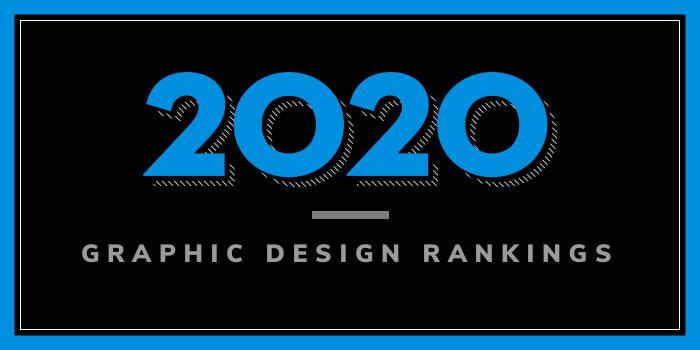
What are the top public graphic design schools of 2020?
| Ranking | School | State | Top % |
|---|---|---|---|
| 1 | North Carolina State University at Raleigh | North Carolina | 1% |
| 2 | University of California, Los Angeles | California | 1% |
| 3 | Virginia Commonwealth University | Virginia | 1% |
| 4 | University of Illinois at Chicago | Illinois | 2% |
| 5 | Portland State University | Oregon | 2% |
| 6 | University of North Texas | Texas | 2% |
| 7 | University of Washington | Washington | 3% |
| 8 | University of Texas at Austin | Texas | 3% |
| 9 | Massachusetts College of Art and Design | Massachusetts | 3% |
| 10 | University of Illinois at Urbana – Champaign | Illinois | 4% |
| 11 | The Ohio State University | Ohio | 4% |
| 12 | University of Georgia | Georgia | 4% |
| 13 | Arizona State University | Arizona | 5% |
| 14 | University of Cincinnati | Ohio | 5% |
| 15 | Texas State University | Texas | 6% |
| 16 | Auburn University | Alabama | 6% |
| 17 | Kent State University | Ohio | 6% |
| 18 | Clemson University | South Carolina | 7% |
| 19 | Appalachian State University | North Carolina | 7% |
| 20 | University of Florida | Florida | 7% |
| 21 | University of Texas at Arlington | Texas | 8% |
| 22 | Michigan State University | Michigan | 8% |
| 23 | University of Arizona | Arizona | 8% |
| 24 | Indiana University-Purdue University Indianapolis | Indiana | 9% |
| 25 | Louisiana State University | Louisiana | 9% |
Our 2020 rankings of the Top 25 Public Graphic Design School Programs in the US. We considered over 300 public colleges with graphic design programs for this year's rankings. For an explanation of ranking criteria, click here.

North Carolina State University (NC State) at Raleigh was established in 1887. The school serves 34,340 students enrolled in more than 300 degree programs across 12 colleges and 65 academic departments. The College of Design houses the Graphic Design program, which offers two degree paths—a Bachelor of Graphic Design and a Master of Graphic Design. The College has recently established a PhD in Design/Information Design Concentration as well.
The undergraduate and graduate degrees are NASAD (National Association of Schools of Art and Design) accredited and the PhD Concentration is set to receive NASAD approval after graduating its first class.
Students in the undergraduate program study comparative ideas about, and methods for, creating visual communication. Sequenced core studios, typography courses, and image-making courses “progressively introduce and develop skills, processes, and sensitivities across a range of media,” says the school. Graduate students will “closely examine the cultural and technological situatedness of graphic design and its products, and seek understanding of the people who use and interact with the things that graphic designers make.”
Students in all programs will explore and become proficient in a wide range of media — print, web, mobile, virtual reality, augmented reality, and embedded technology. Students will also practice visualization strategies such as mapping, diagramming, and storyboarding, they will develop strong formal and conceptualization skills through project-based assignments, and immerse in advanced studios that cover special topics such as data visualization, branding, and accessible design.
Another major highlight of the Graphic Design Program at NC State is the opportunity to gain valuable professional experience through paid internships within leading firms, and/or participate in sponsored studios as part of the graphic design curriculum. Students also have the opportunity to study abroad for a semester or summer at the NC State Prague Institute, or take advantage of other study abroad options.

Founded in 1919 as the Southern Branch of the University of California, University of California Los Angeles (UCLA) serves nearly 45,000 students from all 50 states and more than 100 foreign countries. The school offers 125+ undergraduate majors across numerous schools, 109 academic departments, and more than 40 graduate programs. The School of Arts and Architecture is home to the Department of Design Media Arts (DMA), which offers both BA and MA degrees in Design Media Arts. The DMA program “emphasizes innovative creation with digital and mass media within the context of a public research university,” says the school. The curriculum highlights “a solid foundation in form, color, space, motion, typography, and interactivity, followed by a broad selection of area studies courses in video, visual communication, network media, game design, and narrative.”
Course highlights include Design Culture, Interactivity, Word + Image, Tangible Media, Form, and Typography. In addition, to DMA classes, students complete a series of general education courses and are encouraged to take other electives from the university to broaden their experience. A senior project also allows students to focus on individual interests within the areas of Visual Communication and Image, Interactivity and Games, or Video and Animation.
“This uniquely challenging and diverse program invites students to balance aesthetic sensibility with logical reasoning, formal theories with practical application, and contemporary thought with historical perspective.” With courses that are taught as studios of no more than 22 students, individual growth and a sense of community within the department is encouraged.

Virginia Commonwealth University (VCU) was established in 1838. The school serves more than 31,000 students enrolled in 225 academic programs across 13 schools and one college. An additional four programs are offered at VCU’s Qatar campus. The School of the Arts (VCUarts), which serves more than 3,000 students, offers 25 degree programs. The Department of Graphic Design here has several programs for aspiring graphic designers. Options include BFA degrees in Graphic Design and Communication Arts, and an MFA with a Concentration in Design/Visual Communications.
Students in the NASAD-accredited MFA program “concentrate on the philosophical, communicative, and aesthetic relationships of visual problem solving and the interacting skills leading to the effective articulation of concepts,” says the school. Graduates will have the skills and knowledge needed to pursue a career in Design Education and/or further their professional practices in conducting visual or theoretical research, and in investigating the intersections of function and expression in design problem solving.
The 122-credit BFA in Graphic Design is designed to “educate students to be capable of integrating form and information for the purposes of effective visual communication.” Course highlights for the program include Design Technology, Design Methods and Processes, Imaging, Letterpress, Book Arts, Visual Narrative, Studio Management, and Interaction. Seminar courses are also part of the program.
The Communication Arts BFA is a flexible degree program that allows students to study Advanced Figure Drawing, Scientific Illustration, 3D Modeling, Sequential Imaging (such as comic books and storyboards), Concept Design and Entertainment Design (such as video games and visual effects). “The program is centered on a rigorous investigation of studio methods and practices which explore conceptual and theoretical concerns for understanding and creating image, media, content and context.”
The focus during the junior and senior years is typography, visual studies design, figure drawing, introduction to 3D modeling, the history of visual communications, digital drawing, concept drawing, sequential imaging, advanced illustration, and advanced 3D modeling. The senior year culminates with the capstone portfolio course and a variety of electives are offered each semester to provide students the opportunity for specialized study.
Both BFA options prepare students to create effective visual communications for the advertising industry, marketing, business, retail, entertainment, public relations, publishing and more.

University of Illinois at Chicago (UIC) was formed in 1982 “by the consolidation of two U. of I. campuses: the Medical Center campus, which dates back to the 19th century and the comprehensive Chicago Circle campus which replaced, in 1965, the two-year undergraduate Navy Pier campus that opened in 1946 to educate returning veterans.” Today, with more than 31,600 students enrolled in 250 degree programs and 53 certificate programs across 15 colleges, UIC is the largest university in the Chicago area.
The College of Architecture, Design, and the Arts (CADA) houses the School of Design, which offers a Bachelor of Design (BDes) and a Master of Design (MDes) in Graphic Design. The four-year BDes program highlights studio-based instruction, while the two-year MDes focuses on an independent master’s research project. In the BDES program, “emphasis is placed on perfecting hand skills and in developing proficiency with digital technology,” says the school. “Through exposure to design practice, design culture, and critical observation, students experience Chicago as a global design center.”
The two-year MDes program focuses on an independent master’s research project that offers students the opportunity to explore a topic of inquiry with the potential to inform and shape disciplinary knowledge. Course examples include Advanced Graphic Design, Research Seminar, Documentation Studio, and Research Studio. During the final year of the program, students will participate in the Book Design Masters Project Exhibition.
A third option is the MDes Prelim Program. Offered to applicants who do not hold a bachelor’s degree in design, the Prelim Program is a customized yearlong program that prepares students for the two-year MDes.

Portland State University (PSU) opened its doors in the summer of 1946 to just 220 students. Today, the school spans 50 city blocks, and it houses nine colleges and schools, 226 degree programs, and more than 25,000 students. The College of the Arts is home to the schools of Architecture, Art + Design, Music, and Theater + Film.
With around 1,400 students enrolled, the School of Art + Design offers BA, BS, BFA degrees and Minors in areas from Art History to Graphic Design. The Graphic Design Program has two options: the BFA and an eight-course Minor that includes Digital Design, Digital Imaging and Illustration, and Communication Design Systems, to name a few.
The BFA provides “a comprehensive education in design principles, applications, theories, history, and practice,” says the school. “The curriculum places particular emphasis on craft, concept, and research skills, as well as the development of effective design processes, the generation of meaningful narratives and story-telling techniques, and engagement with various community partners.” Students in the program work with faculty primarily through studio courses that introduce an increasing complexity of design problems and methodologies, combined with opportunities for independent development and interaction with professionals.
The first two years of the program culminate with a required Sophomore Portfolio Review, occurring once each year at the end of the Spring term. Only after successfully passing the Review are graphic design majors allowed to continue progression through the program. First and second year course highlights include Type & Communication Design, Digital Image and Illustration, Interactive Media, Communication Design Systems, and Contemporary Design Projects. During the third and fourth years of the program students “choose courses of increasing specialization, have opportunities for engaging in professional internships, and work to develop a professional portfolio as the culmination of their design studies.”
Summer Study Abroad experiences such as Printmaking and Mixed Media in Guanajuato, Mexico, Art History in Rome, and Berlin: The Fall and Rise of an Art City, are also part of the program.

University of North Texas (UNT) was founded in 1890 as Texas Normal College and Teachers’ Training Institute. With around 39,200 students enrolled, UNT is the fourth-largest university in Texas. The school offers 105 bachelors, 88 masters and 37 doctoral degree programs across 12 colleges and one school. The College of Visual Arts and Design is home to the Design Department, which houses the Communication Design Program. Program options for aspiring graphic designers include BFA, MA, and MFA degrees in Communication Design.
The BFA program covers the basic principles of design, image making, color theory and typography. It is also designed to “help students learn to be effective conceptual thinkers and, most importantly, creative problem solvers in the disciplines of Advertising and of Graphic Design.” The 36 credit hour MA in Communication Design and the 60 credit hour MFA in Communication Design are both taught as concentrations in Design Research.
Students in all Graphic Design programs have the opportunity to complete an internship, study abroad, and access “valuable resources” consisting of over 1,000 reference books, magazines and paper/print samples of photography, illustration, typography, graphic design and advertising.

Established in 1861, University of Washington (UW) serves more than 57,000 students across three campuses in Seattle, Bothell, and Tacoma. The school offers more than 570 degree options across 300+ programs and 16 colleges and schools. The College of Arts & Sciences is home to the School of Art + Art History + Design (SoA+AH+D), which offers a Bachelor of Design (BDes) in Visual Communication Design and a Master of Design (MDes).
One of the largest undergraduate programs at the University of Washington, Visual Communication Design emphasizes “visual problem solving, organizational skills, and information theory.” Students in the programs engage in all phases of typography, information design, design systems, exhibition design, publication design, new media, and visual methods/processes. Sample courses for the BDes include Typography, Human Centered Design, Color + Composition, Interface Design, Motion Design, Visual Systems, Information Design, and Publication Design.
Sample MDes courses include advanced Design Foundations, Design Methods, Typography, Industrial Design, Interface Design, Case Studies in Corporate Identity, Exhibition and Installation Design, Interaction Design, Information Design, Design Graduate Studio, and Graduate Student Teaching Mentorship.
Students in both programs will have the opportunity to compete for more than 100 seats in the SoA+AH+D study abroad program to explore art, art history, and design in an international context. Past students have studied in Rome, Japan, Spain, and Tuscany.

The University of Texas at Austin (UT Austin) was founded in 1881. The school opened its doors in 1883 with one building, eight professors, one proctor, and 221 students. Today, UT Austin is home to nearly 52,000 students enrolled in over 500 degree programs and fields of study across 18 colleges and schools. The College of Fine Arts, School of Design and Creative Technologies has several programs for aspiring graphic designers. Options include BA, BFA and MFA degrees in Design.
BA and BFA Design students develop their research, problem-solving and critical thinking/making skills through studio-based courses, while elective courses and the university’s core curriculum emphasize the liberal arts. In their junior year, students must complete at least one professional internship, which may include working at major companies with offices in the Austin area. Just a few include Google, Dell, IBM, Apple, Samsung, Frog, Pentagram, and EA Games.
The BFA is a pre-professional degree program encompassing typography, image creation/manipulation, interaction design and 3-D design that is intended to prepare students for employment in the field of design. During the senior year, BFA Design students undertake a capstone design project and show their work in a public exhibition at the Visual Arts Center.
The Design BA is an “equally rich and rigorous exploration of design as a field,” says the school, “but is intended for students who prefer the flexibility and breadth of a liberal arts degree to the more studio-intensive, pre-professional BFA degree.” BA students enroll side-by-side with BFA students in rigorous introductory design studio courses. In the final two years of study, BA students take fewer upper-division studio courses.
The MFA in Design is a 60 credit hour program that accepts exceptional students with preexisting design skills. The program prepares students for “thought and organizational leadership in the field of design or in fields where design is being utilized strategically. In addition to advanced studio work in established design disciplines,” students have the “opportunity to study, explore and work in disciplines that intersect with design.”
All students in the program “will enjoy a formal curricular partnership with another discipline on campus and develop a thesis that thoughtfully intersects design with another field such as business, anthropology, engineering, or art.” In addition, the MFA Design program offers preparation for college teaching in the field of design through a series of classes exploring design pedagogy.

Massachusetts College of Art and Design (MassArt) was founded in 1873 as a training institution for aspiring drawing teachers, architects, artists, and designers. Today, the school offers more than 20 undergraduate art programs, nearly a dozen graduate programs, and around seven certificate programs to a population of nearly 2,100 students. Options for aspiring graphic designers include a BFA in Communication Design and a Graphic Design Certificate (GDC).
Students in the Communication Design BFA Program “gain a robust working knowledge of print design, information design, branding, and dynamic media (user experience design),” says the school. Program highlights include hands-on studio classes led by practicing designers and design educators, and internship opportunities. “Throughout the program, students are challenged to develop design solutions in the areas of package design, publication design, web and app design, interactive communication, and advertising, as well as the creation of graphic identities and brand systems.”
The 38 credit hour GDC is designed for working adults who are interested in advancing into a career in graphic design. Areas covered include branding, print and digital publication, interactive media, environmental graphics, and more. Graduates will leave the program with a portfolio of professional quality work.
Graduates of the Communications Design BFA and GDC work for ad agencies, in-house corporate design departments, design studios, and as freelance designers. Some graduates even go on to launch their own start-ups.

Established in 1867 as Illinois Industrial University, University of Illinois at Urbana – Champaign is one of the original 37 public land-grant institutions created after President Abraham Lincoln signed the Morrill Act. The school serves nearly 48,000 students through 15 colleges and instructional units. The College of Fine and Applied Arts, School of Art and Design offers a 122 credit hour Graphic Design program that leads to a BFA. A 64 credit hour MFA in Graphic Design is also available.
The Graphic Design BFA prepares students for entrance into the professional practice of design visual communications. The school says, “studio work addresses graphic design fundamentals (typography and image making), design history and contemporary practices, research methods, user experience, and social responsibility.” In addition, “students have the opportunity to develop their personal interests by taking advantage of a highly interdisciplinary selection of elective courses offered by the School of Art + Design, including Photography, Video, Traditional Printmaking, Sustainability, Advanced Interaction Design, and the design of Ninth Letter, a nationally-distributed and award-winning literary arts journal.”
The MFA prepares students to contribute to the field of design by entering into practice, academia or both. Specialized tracks of study for the program include Sustainable and Regenerative Design, Urban Sociology and Critical Race Design, Visual and Cultural Studies, and (student-proposed) Applied Research in Responsible, Innovation, Social Impact, and Engagement.
Students also have the opportunity to “explore responsible futures through research in traditional print media and emergent technologies including, but not limited to, data visualization, digital interaction, information design, systems thinking, and visual narrative.” Other program highlights include the opportunity to take courses at Siebel Center for Design, collaboration with PhD students in Informatics, who specialize in design, and networking through “world-class” Programs across campus. Students will also develop partnerships at the Research Park—a leading technology hub that cultivates start-ups and accelerates corporate innovation at companies such as Abbott Laboratories, ADM, Ameren, Capital One, and State Farm.

Established in 1870 as Ohio Agricultural and Mechanical College, The Ohio State University offers over 200 majors, minors and specializations from which more than 68,000 students can choose several paths to focus on graphic design in the College of Arts and Sciences’ Department of Design. Options include a Bachelor of Science in Design (BSD) in Visual Communication Design and a Design Thinking Minor.
Students in the BSD program use digital tools, “including advanced computing technology, to visualize and present translations of complex data and ideas,” says the school. Students will “study and explore research-based approaches to the visual design of information, the development of brand identities based on present and future conditions, and the creation of way-finding systems for navigating complex environments.”
The production of printed materials such as books, brochures, packaging, and posters is also part of the program. Sample courses include Design Media 1 for Visual Communication Design, Typographic Design, Materials + Processes for Visual Communication Design, Design Research, Collaborative Design, Professional Practices, Sustainability and the Built Environment, and Design Matters. In their senior year, designers will complete a final project “that demonstrates each student's comprehensive knowledge and ability to work independently.”
The Design Thinking Minor is a 15 credit hour program that introduces students to new and creative ways to solve problems. Courses include Design Practice, Design History, Exploring Design Thinking, Visualization as Thinking, and Presentation as Thinking.
Graphic design students who would like to pursue graduate study at OSU have two options: the MFA in Visual Arts offered through the Department of Art and the MFA in Digital Animation and Interactive Media offered through the Department of Design. The MFA in Visual arts offers emphases in seven studio areas: Art and Technology, Ceramics, Glass, Painting and Drawing, Photography, Printmaking, and Sculpture. The 66 credit hour, three-year program allows students to work across disciplines and with faculty from all seven studio areas.
The MFA in Digital Animation and Interactive Media allows students to select courses that cover visual design, technical skills for animation and interactive media, programming and algorithms, audio design, writing and scripting, and professional development. Students in all graduate art programs have 24/7 access to private and semi-private studio spaces as well as The Wexner Center for the Arts—a world-renowned contemporary art center located on campus; The Fine Arts and Cartoon Libraries; and the Urban Arts Space—an off-campus, OSU-run gallery in downtown Columbus. The Urban Arts Space is the location of the third-year thesis exhibitions.

Established in 1785, University of Georgia (UGA) serves 38,920 students enrolled in more than 370 fields and areas leading to the bachelor’s, master’s, specialist education, professional, or PhD degree. Programs are offered in 17 schools and colleges, including the Lamar Dodd School of Art—home of the Art Program. Options for aspiring graphic designers include a BFA in Art with Concentrations in Graphic Design, Printmaking & Book Arts, and ArtX: Expanded Forms. An Interdisciplinary Art & Design A.B. (BA), a Minor in Studio Art, and MFA degrees in ArtX and Printmaking are also on the menu.
The school says, “all BFA degrees include the Studio Art Core, comprised of a year-long survey of art history, introductory-level studio foundations, secondary-level ideation and methodologies, and upper-level interdisciplinary thematic studio and professional practice courses.” The Graphic Design pathway stresses “a strong grounding in design and communication fundamentals like typography, information hierarchy, concept development, and visual exploration.”
Students in this program can expect to take courses such as Graphic Systems, Type & Image, Visual Narrative Systems, Advanced Typography, Thematic Inquiry in Contemporary Art and Environmental Graphic Design. Electives include Data Visualization, Advanced Illustration, and Topics in Digital Platforms & Dynamic Media, to name a few.
Students seeking the BFA degree will enter the School of Art as Intended Art majors. “In most studio programs, students are required to present an exhibition or final portfolio that serves as a capstone experience before graduation, demonstrating their achievement in developing a mature and cohesive body of work.”
All art and design students have access to a large study abroad program that offers experiences on all seven continents and UGA campuses in Costa Rica, Central America, Cortona, Italy, and Oxford, England.

Founded in 1885, Arizona State University (ASU) serves more than 110,000 students across six campuses. The school offers more than 290 academic undergraduate programs and hundreds of graduate programs across 17 colleges and schools. The Tempe campus serves 51,585 students, making it the largest campus in the ASU system.
The ASU Herberger Institute for Design and the Arts houses the Design School, which offers programs in the areas of Architecture, Environmental Design, Industrial Design, Interior Design, Landscape Architecture, Urban Design and Visual Communication Design/VCD (Graphic Design). Visual Communication Design (VCD) options include a BSD in Graphic Design, an MSD with a Concentration in Visual Communication Design (VCD MSD), and a Master of Visual Communication Design (MVCD).
The BSD allows students to work on projects in the areas of Information Design, Interaction Design, Exhibition Design, Animation, Motion Graphics, Branding, Publication Design, Web Design, Interface Design and multiple contemporary facets of sensorial design. The MSD for individuals interested in “advanced studies in visual language, history, theory, criticism and methodology, design processes and technology.” The degree “develops an understanding of contemporary graphic design issues through specialized research and design skills. It also prepares the graduate student for a career in graphic design education.”
The MVCD has two options—a two-year studio-based program and a 3+ program. The two-year studio program is designed for students with a degree in VCD or Graphic Design and a 3+ program is designed to be a first professional degree for those students who do not have an undergraduate degree in VCD or Graphic Design.

Founded in 1819, the University of Cincinnati (UC) serves more than 46,300 students enrolled in 370 degree programs across 13 colleges and a graduate school. The College of Design, Architecture, Art and Planning (DAAP) houses the Myron E. Ullman Jr. School of Design, which offers a BS in Communication Design. The program, which takes five years to complete, offers three concentration areas including Graphic Design, Motion Design, and Interaction Design.
Students in the BS program will take a broad range of courses such as Foundational Drawing and Design, Kinetic Communication, Typography, Photodesign, and Design Ideation. Courses are supplemented with general education requirements, directed electives, design history, and interdisciplinary courses in design thinking and user-centered design. Studios “will refine and develop specific or general skills,” says the school “and be enhanced with further study in design history, methodology, research methods, and global studies.” Students in the program also reinforce their skills in the field through several co-ops.
Besides the BS in Communication Design, aspiring graphic designers might consider another program offered through UC’s Blue Ash College. The Art and Visual Communication Department here offers a two-year Associate Degree in Applied Graphic Communication. The program is designed for “students seeking foundational skills appropriate for further study in the design field or for employment in areas of design support.” Classes are small, so students receive considerable personal attention and direction from faculty. Though the program is a two-year degree, students may take up to three years to complete it.
Graduates of the Communication Design and Graphic Communication programs at UC have career opportunities in advertising, branding and corporate identity, digital product design, exhibit design, interface design, motion graphics and post-production design, package design, service design, user experience design, and web design. They may be found working in the “healthcare system or for governments and NGOs impacting society. Established designers may create their own firms or pursue entrepreneurial activities.

Founded in 1899, Texas State University, San Marcos (TXST) serves more than 38,000 undergraduate and graduate students enrolled in more than 200 bachelor’s, master’s and doctoral degree programs — from biology to music to business to geography and more. With two campuses in San Marcos and Round Rock, Texas, TXST offers programs through 10 colleges, including the College of Fine Arts & Communication—home of the Communication Design Program, which offers both BFA and MFA pathways.
The school says that the Communication Design Program is “one of the largest public programs in the country.” BFA students have three areas of professional study to choose from including Graphic Design, Art Direction, and Interactive Media. Courses in art direction, brand experience, corporate identity, design research, environmental graphics, human centered design, interactive design, sustainable packaging and typography prepare students for professional practice within a designer/client relationship. Students may further their education with independent study courses and professional internships.
Communication Design courses are taught in a studio environment, with class sizes limited to approximately 16. Students have access to the Mitte Complex, which has Macintosh labs, an open lab for student use, digital color printing availability including RISO, digital still and video camera checkout, and a photography studio and a multidisciplinary innovation lab equipped with laser cutter, CNC router, 3D printer and die cutter.
The MFA curriculum is “designed to provide advanced study in the areas of corporate advertising art direction, graphic design, and digital media design. The graduate program will provide students with the following: advanced problem-solving methodologies, updating technological advancement relating to communication design, examination of historical events within the discipline, and emerging theoretical constructs.”
“Web-based delivery is heavily featured in course curriculum, as well as online video conferences, live chat, and blogging interfaces. In addition, the program offers courses via extended weekend seminars, evening courses, and independent directed study. This non-traditional structure allows active professionals to participate.” The MFA program also offers “limited graduate assistant positions for qualified students who wish to immerse themselves full time in their graduate studies.”
For students seeking a future career in higher education, the program provides the appropriate academic credential and the terminal degree in the discipline of visual communication design: the MFA.
“The exchange of ideas on an international basis is an important component of the MFA Communication Design program.” Guest professors from around the world visit the TXST campus to” lecture and share their unique perspective on communication design with graduate students. In addition, selected students are encouraged to participate in international field trips to expand their knowledge in the field of communication design.”
TXST Communication Design students have had their work published in CMYK, Step Inside Design, Graphis New Talent Annual, and PRINT. Students have also received recognition in national, regional, and local competitions such as The One Show, American Advertising Federation Awards, National DSVC Student Show, Creative Summit, Art Director's Club of Houston, Austin Addy Awards, and San Antonio Addy Awards.

Established in 1856 as the East Alabama Male College, Auburn University serves a co-ed population of 30,460 students enrolled in more than 140 degree options across 13 colleges and schools. The College of Architecture, Design and Construction is home to in the School of Industrial + Graphic Design. Program offerings for aspiring graphic designers include a BFA in Graphic Design (BFA GDES).
The program emphasizes Fine Arts, Exhibitions, Identity Development, Logos, Visual/Digital Interface, Packaging, and Magazine Design. In addition, the school says, “students have excellent opportunities for internship and cooperative education experiences as a result of well established relationships with regional, national and international companies and firms.” Career opportunities range from “the development of strategies to implement large-scale communications campaigns, to the design of effective communication products such as magazines, logo and identity development, interactive media, web design, packaging, exhibitions, illustration, and environmental graphics.”
Auburn GDES is the only Graphic Design Program in Alabama to receive NASAD accreditation.

Kent State University (KSU or Kent State) was founded in 1910. The school serves, which consists of an eight-campus system, serves approximately 43,457 students enrolled in more than 300 degree programs across dozens of colleges and schools. The College of Communication and Information, School of Visual Communication Design, offers several programs for aspiring graphic designers including BFA, MA, and MFA degrees in Visual Communication Design and a Design Minor.
The BFA program consists of approximately two-thirds of the coursework in the "creation and study of the visual arts," says the school, with the remainder in general studies. Because of the greater emphasis on upper-level studio courses, the BFA allows majors the opportunity to build greater expertise in a given area of the field.
The MFA is one of only three programs in the state to offer the Master of Arts degree in Visual Communication Design and was the first to offer the terminal degree in the field, the Master of Fine Arts. The MA is a 32 credit hour program that prepares students to work in emerging markets such as social media, branding, digital media and user experience design. The MFA “serves students with a strong undergraduate and/or professional experience in design who wish to advance into leadership roles.” Graduates “typically pursue careers in design education, but also stand out in the industry for their ability to solve problems from a research-based design perspective.”
The Design Minor provides students with “grounding in the fundamental elements of graphic design, including design research and history, graphic software, industry standards and professional ethics.” All School of Visual Communication Design students must complete 300 hours of internship before graduation. Most internships are paid, and students have the opportunity to work at major companies across Cleveland and in Chicago, San Francisco, and New York.

Founded in 1889, Clemson University serves nearly 26,000 students enrolled in more than 280 undergraduate majors, minors, and graduate programs in seven colleges. The College of Business, Department of Graphic Communications offers a BS in Graphic Communications that the school says is “dedicated to hands-on learning experiences.” Students in the program are “placed in positions in a variety of printing, packaging, publishing, imaging and related industries in management, marketing, sales, customer service, creative, technical and scientific positions.” The school says that placement rates are “consistently high” with “competitive salaries.”
In addition to engaging in hands-on learning experiences, Graphic Communications students will take courses such as Digital Imaging and eMedia, Packaging Science, Ink and Substrates, Package and Specialty Printing, Commercial Printing, Technical Writing, Current Developments and Trends in Graphic Communications, and Marketing. Graduates of the program are prepared to enter the schools MS in Graphic Communications or seek positions in printing management, production planning and supervision, commercial and technical sales, and many others.
The MS in Graphic Communications includes 33 credit hours of graduate courses for the non-thesis option or 30 hours with a thesis. Within the total requirements, at least 17 hours will be in GC technical/managerial courses; seven will be research related; six credits will be from outside the Graphic Communications Department; and at least one-half will be at or above the 8000 level.
Graduates of the program are placed in positions in a variety of printing, packaging, publishing, imaging and related industries in management, marketing, sales, customer service, creative, technical, scientific, and academic positions.

Appalachian State University was founded in 1899. The school serves approximately 19,280 students enrolled in more than 220 academic programs through the College of Arts and Sciences, College of Fine and Applied Arts, Reich College of Education, Walker College of Business, Hayes School of Music, Beaver College of Health Sciences, and Cratis D. Williams School of Graduate Studies. App State also offers a Doctorate of Education.
The College of Fine and Applied Arts houses the Department of Art, which offers several programs for aspiring graphic designers. Options include a BFA in Graphic Design and BS degrees in Graphic Communications Management – Cross Media Production (GCM – CMP) or Print/Packaging Production (GCM – PPP).
The program consists of 66 semester hours in Art Studio and related areas and 12 semester hours in Art History/Criticism and allows students to take a mix of both prescribed and elected courses in art, concentrating on individual strengths and interests. Sample courses for the program include Typography, Digital Imaging, Calligraphy, Interaction Design, Idea Lab, Motion Graphics, Sign, Symbol, Image, Design Methods, and Graphic Design Professional Practice.
Graduates of the BFA program “will be prepared to successfully contend for the rigorous and highly competitive careers in graphic design as well as for admittance into graduate level programs,” says the school.
The BS in GCM-CMP “focuses on applying graphic messaging across different channels/platforms such as web, email, print, cover wraps, etc. to communicate to various markets.” Sample courses include Digital Media Composition, Cross Media Production, Packaging Production, Web Development for Graphic Communications, and 3D Imaging and Animation. An industry internship is also part of the program.
The BS in GCM – PPP “covers a wide variety of processes and methods of production.” This includes flexography, digital printing systems, offset lithography, variable data printing and wide format printing “in addition to the design and production of packages that protect and promote products in channels of distribution.” Students in this program can expect to take many of the same courses required in the GCM – CMP program, as well as courses such as Advanced Packaging Production and Sustainability for Graphic Communication. This program also requires completion of an industry internship.

Founded in 1858 as Gainesville Academy, University of Florida (UF) serves more than 56,000 students enrolled in 30 certificate programs, 100 undergraduate majors and 200 graduate programs across more than a dozen colleges and schools. The College of the Arts houses the School of Art + Art History, which offers a BFA in Graphic Design, an MFA in Design and Visual Communications (MXD), and an Undergraduate Certificate in Graphic Design.
BFA students enjoy a “rich and intensive studio experience,” says the school, that allows them to “take art and design to the maximum depth possible in preparation to be an artist or designer, or to continue further study in art and design via a graduate program, or to even begin a career path directly related to the arts.” Students can choose from emphases in Ceramics, Art + Technology, Painting, Drawing, Printmaking, Sculpture, and Creative Photography.
The MFA has two- and three-year options that consist of 60 credits total (terminal degree). This includes 24 credits in graduate design courses (research seminars, studio and fieldwork practice), 15 credits of open elective, six credits of practicum, and 15 credits for the MFA project, which is self-directed and designed, allowing students to focus in any area of Design and Visual Communications.
When comparing the two- and three-year MFA options, the three-year option is for students funded with an assistantship or fellowship. Along with funding, the University of Florida provides tuition remission for nine credit hours per semester. The two-year option is for students who are self-funded or have other sources of funding and desire an accelerated path. Students should be mindful of the time commitment that four to five courses per semester and any part-time work will require.

University of Texas at Arlington (UTA) originated as Arlington College in 1895. The school began with roughly 75 students. Today, total global enrollment for UTA is nearly 60,000. The school offers more than 180 degree programs across nine colleges, including the College of Liberal Arts (CoLA), which houses the Department of Art and Art History. Here, students can earn a BA, BFA or MFA in Art that covers Visual Communication (Graphic Design, Web Design, App Design, Game Design and Illustration), Emerging Media, Intermedia, Film and Video, Printmaking, Drawing, and more. Course highlights include Sign and Symbol, Publication Design, Three-Dimensional Design, History of Graphic Design, Information Visualization, Digital Media, Advanced Typography, Web Typography, Sustainable Design, and Advanced Printmaking.
Students in Graphic Design will complete Graphics Portfolio Preparation, which concentrates on the creation, development, and evaluation of the graphic design portfolio. BFA students will complete the Senior Exhibition/Presentation course as well and internship opportunities are offered in all programs.
MFA students must take 60 semester credit hours over six semesters of the three-year program. The student will be required to spend a minimum of three semesters in the MFA program with one academic year in residency as a full-time student. Thirty-nine credit hours are reserved for the concentration, with the remainder dedicated to supporting studio courses, art history courses, and free electives.
Students are required to take courses such as Research in Visual Communication, Critical Perspective in the Visual Arts & Visual Communication, Research in Studio Intermedia, and Creative Strategies. Elective options run the gamut from Research in Printmaking to Research in Photography Digital Imaging. Independent Study is also part of the program as well as the Thesis Exhibition.
Graduates of the Art programs at UTA have career opportunities such as Graphic Designer, Illustrator, Photographer, Art Director, Exhibition Designer, Art Dealer, Printmaker, Animator, Web/App Designer, and many others.

Founded in 1855, Michigan State University (MSU) serves around 50,350 students from 142 countries, every state in the United States and every county in Michigan. MSU students have access to more than 200 programs across 17 degree-granting colleges. The College of Arts & Letters, Department of Art, Art History, and Design, offers an MFA that allows students to select a track such as Graphic Design, and a BFA in Graphic Design that offers the unique opportunity for students to gain real-world design experience by offering design services to the community.
The school says “MSU's Design Center in the Department of Art, Art History, and Design works with internal and external clients to effectively communicate the client's messages in a professional manner. From logos to packaging, and brochures to websites, Design Center has worked on a variety of projects, each specifically targeted to address the goal and personality of an individual client.”
Undergraduate students who “exemplify creativity, dedication, and professionalism in the Graphic Design Program” are selected to join the Design Center creative team each year.
Other program highlights include the opportunity to select concentration courses structured to address several career options within the discipline, internship opportunities, AIGA membership, and the Annual Visiting Artist & Scholar Lecture Series. Recent lecturers include Massimo Vignelli, Martin Venezky, Ben Fry, Nancy Skolos & Tom Wedell, James Victore, Andrew Blauvelt, Jim Sherraden of Hatch Showprint, Stuart Bailey, Jan Wilker, Cheryl Towler Weese, Hans Allemann, and Karen Cheng.
Graduates of the Graphic Design Program at MSU hold positions as creative directors, art directors, graphic designers, freelancers, and video editors with design firms, advertising agencies, production companies, publishing companies, and in-house design offices. Career concentrations include identity system, environmental signage and exhibition, magazine and book, web site, software interfaces, film titles and broadcast television graphics, typeface, packaging, poster, corporate branding, and retail design, etc.

Established in 1885, University of Arizona was the state’s first university. The school serves nearly 46,000 students enrolled in hundreds of bachelors, masters, and doctoral degrees, and first professional and specialist programs, in dozens of colleges and schools. The College of Fine Arts houses the School of Art, which offers BFA and MFA degrees in Studio Art with an Illustration and Design (I+D) Emphasis. Separate tracks in Illustration and Design are offered to undergraduates.
The Illustration Track provides “rigorous education in constructive anatomy,” says the school. Students will “learn to describe the human form realistically and expressively and find personal methodologies in traditional and digital media.” Graduates will leave the program with a professional portfolio and “knowledge of the history of Illustration as well as, the guidelines for ethical professional business practices in the field.”
The Design Track “provides a foundation in design principles and methodologies, creative problem solving and digital processes.” As students advance in the program, they will gain “knowledge and skills in professional practice including identity systems, web design, typography, motion graphics, history, contemporary criticism, and theory.” Graduates will leave the program with a professional portfolio and “a broad understanding of the business of design as well as its potential as a medium of critical inquiry and community involvement.”
The MFA is a 60 unit terminal degree comprised of interdisciplinary, graphic design and illustration courses as well as seminars, and independent studies “developing a body of self-authored work that contributes to the broad and expanding field of illustration, design and art.”
“Focused studio and course structures explore the theory, philosophy, and making of contemporary illustration, design and art. The program provides a range of opportunities for focus in visual narratives, community engagement, social practice, environmental projects, and technology, with a firm grounding in contemporary and historical contexts.”
Students in all Art Programs have access to studio spaces, computer labs with Wacom Cintiq Touch screens and animation stations, a digital imaging lab with large format printing, mounting and other services, letterpress equipment, photopolymer platemaking equipment, metal and wood type collections, binding equipment, darkrooms, wood and metal shops, sculpture foundry, and ceramics labs. Students also benefit from external resources such as the Center for Creative Photography, the University Museum of Art, and the Poetry Center, as well a library that houses an extensive book art collection.

Established in 1969, Indiana University-Purdue University Indianapolis (IUPUI) was created after Indiana University (est. 1891) and Purdue University (est. 1869) merged their numerous programs and schools. Today, across the system, the school serves more than 45,000 students from 50 states and 142 countries, enrolled in 350 undergraduate, graduate, and professional programs. Seventeen schools grant degrees in Engineering, Health Sciences, Liberal Arts, Life Sciences, and more.
The Herron School of Art + Design at Indiana University-Purdue University offers BFA and MFA degrees in Visual Communications Design (VCD). BFA program highlights include access to collaborative classrooms and eight VCD studios, the opportunity to enhance the degree with a Minor in Book Arts or Studio Art and Technology, and classes taught by faculty who are working professionals in the field. VCD students also have access to research and studio spaces including the Think It Make It Lab, woodshops, photo lighting studios, book arts studio, and the Herron Art Library.
The final semester of the BFA program culminates in a capstone project that students develop with a focus on either service experience or digital experience design. A shared senior exhibition is also part of the final semester.
The MFA in VCD “focuses on forms of inquiry and actions involved in designing,” says the school. The program is “experiential, involving both group and individual projects.” In seminars, methods, and action research studios, students will develop knowledge, skills, and practices that will be applied to the final thesis research project. Course highlights for the program include Methods for Design Research, Seminar: Leadership in Design Practice, Collaborative Action Research in Design, Thesis Writing, and Methods for Design Synthesis.
Herron VDC alumni have landed positions at “powerful” companies such as Google, Humana, Samsung Research America, and many others.

Louisiana State University (LSU) was founded in 1853 under the name Louisiana State Seminary of Learning and Military Academy. The school serves approximately 31,761 students enrolled in more than 220 programs through over a dozen colleges and schools. The College of Art and Design houses the School of Art, which offers two programs for aspiring graphic designers: a BFA in Studio Art with a Concentration in Graphic Design and an MFA in Graphic Design.
The 120 credit hour BFA program helps students develop skills in typography, print and editorial design, information design, digital imaging and motion graphics, packaging, environmental design, identity design, and branding. Course highlights include Graphic Abstraction, Two-Dimensional Design, Three-Dimensional Design, Digital Art, Prepress Production Techniques, Interactive Multimedia Design, Digital Imaging Techniques, and Applied Typography.
Per the school, the 60 credit hour, three-year MFA program includes “research and discourse of both modernist and postmodernist methods, strategies, and analysis of the practice of design and their implementation to contemporary graphic design.” Students in the program will take 27 graduate studio hours, 12 art history hours, 12 studio art/general elective hours, and a three-hour teaching seminar.
Courses are supplemented by workshops and lectures by national and international visiting artists, scholars, and design professionals. The final year of study is “dedicated principally to the master’s thesis—submitted as a thesis report and exhibition, for which it is anticipated that students will make original and comprehensive student-directed research investigations in graphic communications.” The thesis is worth six credit hours.
